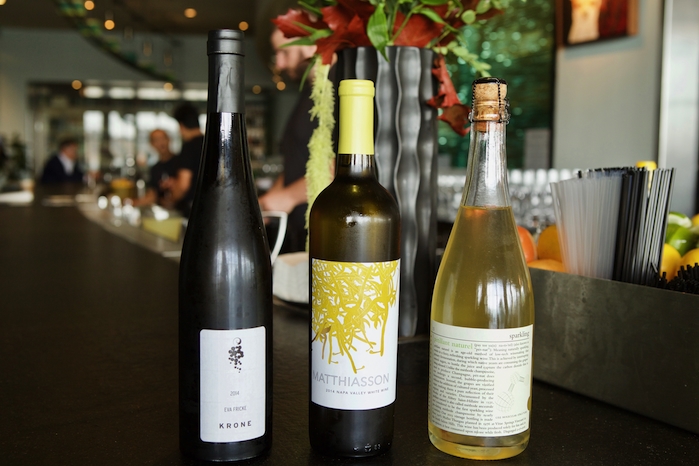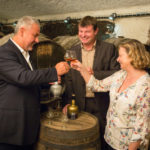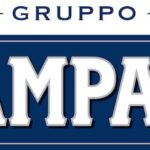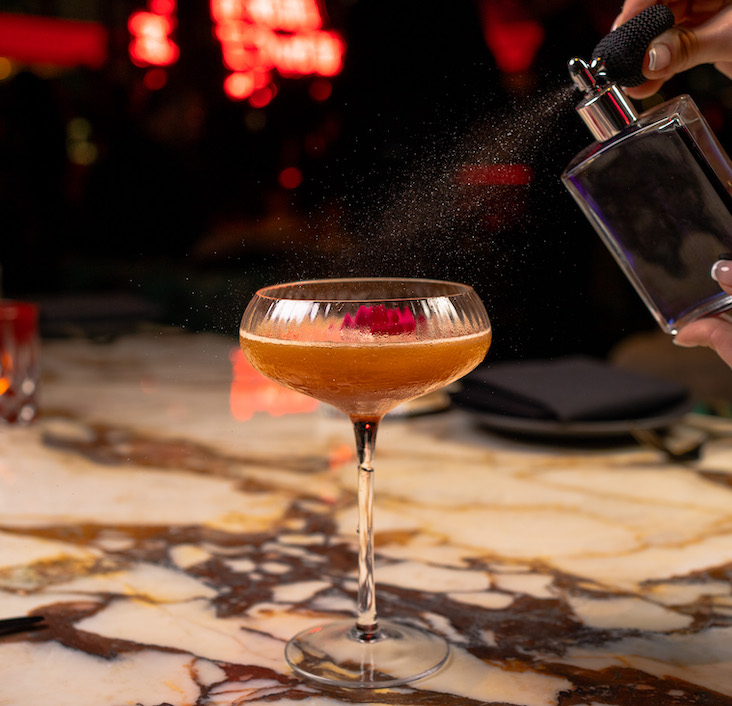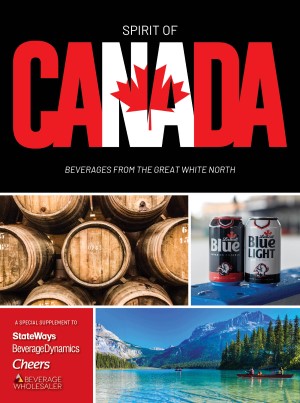Many guests today expect wine, beer and spirits made with environmentally friendly methods, as well as closed-loop cocktails that lessen or eliminate waste behind the bar. Operators who practice what they preach share the techniques and philosophies they’ve implemented to serve drinks you can feel good about.
Eco-Friendly Oenology and More
The Slanted Door has been at the forefront of the California farm-to-table movement for the past 20 years, serving ingredients and beverages that are organically or biodynamically farmed or sustainably caught. The entire philosophy of the 300-seat, family-run modern Vietnamese restaurant in San Francisco (part of the four-concept Slanted Door Group) is connecting farmers and producers with their dining guests–and that extends to the wine program.
“The wine list philosophy is predicated on the idea that wine is food, and in that respect needs not only to be in balance and to complement the delicacy of our cuisine but to be transparent as a product,” says Chaylee Priete, Slanted Door Group wine director. “I find it of the utmost importance that our staff and sommeliers be able to talk about the connection between place and taste, so we focus on small producers who work either organically or biodynamically making hand-crafted, terroir-driven wines.”
The Slanted Door currently has about 200 wines on its list. Admittedly, not every wine is certified organic or biodynamic, but each is required to hail from a producer who works ecologically and sustainably.
Priete cites two bottles in particular that exemplify the kinds of wines on the menu. The 2014 Mattiasson White (priced at $75 a bottle) is a blend of semillon, sauvignon blanc, tocai and ribolla gialla from organic vineyard manager Steve Matthiasson. The 2015 Minimus Petillant Naturel of Muller Thurgau ($52 a bottle) is made by Oregon winemaker Chad Stock, using native yeast and minimal sulfur.
Priete believes that Chris Brockway of Broc Cellars in Berkeley, CA, most “represents the shift in California winemaking over the last decade to small artisans working with minimal intervention [and] native yeast, employing old world techniques to make beautiful food appropriate wines.” Brockway is also a good example of the younger generation of producers who buy grapes through contracts rather than sourcing them from owned vineyards, she notes.
Because of the restaurant’s location in the Bay Area, Priete believes that guests at The Slanted Door are extremely sensitive to whether the food and beverages served there are sustainable. When the list was smaller, symbols next to the wines designated organic or biodynamic farming, but as the list grew and the criteria for inclusion became more strict, she removed the symbols as they just became too confusing.
The Slanted Door’s sustainability focus also includes buying from smaller producers, composting food scraps, donating leftovers to the Food Runners who distribute them to those in need, and collaboration with Surfrider Foundation to better make use of waste.
Fin & Pearl in Nashville also strives to be as earth-friendly as possible in both its operational practices and buying strategies. For beverages, the 255-seat seafood restaurant sources locally as much as possible, buys draft beers from Nashville area craft breweries, selects sustainable wines and spirits and crafts cocktails using local ingredients and those grown in-house, says general manager Toni Thomas.

Fin & Pearl in Nashville buys draft beers from local craft breweries, selects sustainable wines and spirits and crafts cocktails using local ingredients and those grown in-house.
Out of the 74 wines on the menu, 11 are sustainable, including the full-bodied and vibrant Cakebread chardonnay ($125 a bottle). It’s from a Napa Green Certified Winery that uses energy-efficient refrigeration pumps, controllers and lighter, maintains organic vineyards, reduces water use and encourages recycling.
Jordan cabernet sauvignon ($148 a bottle) is well balanced between fruit and tannins; the winery is a member of the Sonoma Green Business Program and is fitted with energy-efficient technology. “The ranch manager plants cover crops to improve soil health and promote insect growth,” Thomas points out. “The winery also makes its own compost using landscape debris, manure, vine and tree prunings and food scraps.”
Michel Redde et Fils sauvignon blanc ($100 a bottle) “expresses the aromatic, mineral and saline pureness of the soil,” Thomas says. Vineyards are maintained without herbicides, insecticides or other synthetic additives.
On the beer side, one of the favorite breweries on tap at Fin & Pearl is Tennessee Brew Works, the first brewery in North America to use the Meura Micro mash filter–which results in the greenest brewing process. “Using this filter allows for reduced grain usage, a wider variety of grain usage, higher sugar extraction from malt, and huge savings in water usage,” Thomas says. “It also speeds up the brewing time, which saves on both energy and labor.”
Staff rotates the drafts, offering options such as the 1927 IPA for $6, which uses seven varieties of hops and pairs well with spicy dishes and citrus glazes and dressings.

Fin & Pearl’s garden-to-glass Bloody Mary is made with Woody Creek vodka, house mix, lemon and orange juices, Worcestershire sauce, molasses, a secret combination of spices. For $2 extra it can be garnished with sustainably sourced Gulf shrimp.
Woody Creek vodka and gin, Casa Noble tequila, Prairie vodka and Del Maguey Vida mezcal are some of the sustainable spirits on the backbar, used in garden-to-glass cocktails. The Bloody Mary ($10), for instance, is made with house mix, lemon and orange juices, Worcestershire sauce, molasses, a secret combination of spices. For $2 extra it can be garnished with sustainably sourced Gulf shrimp.
Fin & Pearl values products that are produced via fair trade and organic methods, as well as those that are non-GMO. It only works with purveyors catching high quality fish via small, privately owned boats.
The restaurant uses ORCA (Organic Refuse Conversion Alternative), which turns food waste into environmentally safe water within 24 hours, which goes into the municipal sewage system. Water glasses are made from rescued wine bottles, drinking water is filtered using the Blubar Water System, and waste that cannot go into ORCA is recycled or composted when possible.
Cocktails, Rooftop to Glass
Firefly is a 110-seat restaurant serving comforting American fare at the Hotel Madera in Washington, D.C. When lead bartender Brendan Ambrose started at Firefly, he heard a staff member mention how it was a shame that the rooftop box garden had gone untended when the most recent gardener had moved on to another gig.
So Ambrose began arriving early to his shift every day to weed and cultivate its fruits, vegetables and herbs. He’s been seeing the fruits of his labor, growing herbs including chamomile, lavender, mint, basil, sage, rosemary and thyme, summer produce like watermelon, cucumber, beans, sugar snap peas, peppers and flower garnishes, and squash, radishes, carrots and rare red basil for the cooler months.
“My two passions in life are growing amazing ingredients and creating stunning cocktails with them,” Ambrose says. “[Parent company] Kimpton gives me the freedom and encouragement to do both.”
He updates the cocktail list quarterly, and a recent menu used about 80% of what’s grown on the roof. All cocktails are garnished with edible flowers and herbs sourced from there as well.
The Aw, Snap ($15) shakes Plymouth gin with Cointreau, fresh-pressed snap-pea-tarragon and rosemary-thyme syrups, while California Dreaming ($15) mixes Hendrick’s gin with freshly-pressed honeydew and cucumber, mint simple syrup and lemon.

Firefly cocktails include The Aw, Snap, made with Plymouth gin with Cointreau, fresh-pressed snap-pea-tarragon and rosemary-thyme syrups.
For The Roof is On Fire ($15), Chartreuse-soaked garden herbs are placed in a rocks glass and set on fire; a large ice cube is placed on the flaming herbs, then extinguished with Grey Goose vodka, coconut water and a garden-herbal tea tincture.
While Ambrose isn’t sure if the average guest seeks out a sustainable cocktail program, it does make an impression. “Once [they] hear our garden story and taste our cocktails, that aspect adds to the reasons why they return.”
And it doesn’t stop at those 6-ft. by 6-ft. wooden boxes. Firefly’s tables are made with salvaged barn wood, glassware hails from recycled wine bottles, corks are recycled and many of their house syrups, cordials, bitters and garnishments are made from repurposed food scraps. “There are countless touches that reflect our commitment to sustainability,” Ambrose says.
Tackling Sustainability in Bars
It’s not always easy to implement sustainable beverage practices–or even to figure out where to start. Outside consultants can help.
For instance, Tin Roof Drink Co., launched in 2014 and spearheaded by Claire Sprouse and Chad Arnholt, helps bars target three areas: ingredient sourcing (including carbon footprint and ethical production), energy and water waste and actual physical waste.
It gets a bit trickier with spirits, as there can be a conflict of interest in the carbon footprint, agricultural impact and responsibility to the human element, says Sprouse, who currently serves as bar manager at Sunday American restaurant in in Brooklyn, NY. For example, a whiskey crafted with non-GMO grains might need to be shipped longer distances than one from “green” distillery that sources grains from a less than reputable farmer.
“We always say that how you prioritize these challenges in your bar is a reflection of your own personal beliefs and what challenges your local community faces,” Sprouse explains. Spirits sustainable from all angles don’t exist, she admits; but operators should be looking through a sustainable lens when stocking the bar.
The duo consults with different bars and restaurants on implementing best practices. At Sunday in Brooklyn, de-juiced citrus pieces are dehydrated and blended into spices, and corncobs and husks get infused in rum.

Claire Sprouse and Chad Arnholt run Tin Roof Drink Co., a consulting firm on sustainable beverage practices for the bar world.
At The Bywater in Los Gatos, CA, the goal was to lessen water usage and waste while building a New Orleans-inspired drink menu. To that end, they measured the amount of water that went into each drink, and then reduced it by using more efficient ice machines and changing the way drinks were built.
There is a misperception that being sustainable behind the bar automatically translates to being more expensive, but Sprouse says that’s not necessarily true.
“Some practices and choices that may require initial investments can actually result in greater savings–think energy or water efficiency,” she points out. “Likewise, closing the loop on ingredients in cocktails maximizes what is already in-house, which simultaneously has the added benefit of reducing bottom lines.”
There is also the belief that it’s all or nothing, but you can “take small steps and build from there,” she advises, such as eliminating wasteful, non-compostable plastic straws from cocktails.
Consumers are becoming more savvy with all types of products these days, from coffee and cars to food and wine. “Cocktails aren’t immune to that scrutiny,” Sprouse says. “To not get ahead of people’s expectations when it comes to being environmentally conscious with their alcohol choices will eventually leave you left behind with a bar full of empty seats.”
Kelly Magyarics, DWS, is a wine, spirits and lifestyle writer and wine educator in the Washington, D.C. area.

